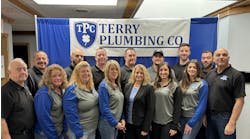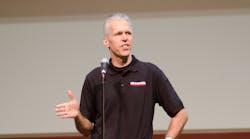Latest from Plumbing Contractor
Sponsored
Grainger Show 2013 highlights sustainability, safety
ORLANDO, FLA. — This year, more than 14,000 Grainger customers attended the Grainger Show in Orlando, Fla., March 10-12. Attendees had a chance to visit with more than 600 Grainger supplier partners during the trade show and attend educational seminars and networking discussion groups.
During an exclusive media event, Jim Ryan, Grainger chairman, president and CEO, said that Grainger customers are cautiously optimistic regarding the business climate. They are looking for efficiency, and Grainger continues to help customers increase efficiency even in the tough economic environment.
“Right now there is uncertainty around healthcare costs and tax environments,” said Ryan. “There is also an uncertainty in global economic environments. It is difficult for companies to hire people right now. However, companies are becoming more profitable now and have ideas of where to invest.”
Grainger is making significant investments in areas such as e-commerce, safety and sustainability.
“Grainger was the first company in the industry with website presence, and we have been aggressively investing in e-commerce,” said Ryan. “The Internet is time saving, which saves money for our customers.”
Ryan added that Grainger is the largest safety distributor in North America, and works with small shops to very large corporations. “Worker safety is getting a lot of attention in the U.S.,” said Ryan. “The cost of non-compliance is going up, along with the cost of lost time from accidents.”
Sustainability is another area Grainger is investing in that equates to cost savings. The company provides a sustainable product catalog and a sustainability consulting service. In 2008 there were 8,000 sustainable products in the catalog, and the catalog has grown to about 18,000 sustainable products.
“We saw more and more customers asking for green products,” said Jeff Rhem, Grainger corporate sustainability manager. “So we wanted it to be easier for customers to identify these products. We worked with UL to figure out what products are actually sustainable, to include in the catalog, so customers are not green washed.”
Grainger not only offers its customers sustainable products, but the company has made a commitment to build sustainable. All of Grainger’s new facilities will be U.S. Green Building Council LEED certified. Grainger already has a handful of LEED buildings in its portfolio: in Sept. 2011, the new Minooka, Ill., distribution center received LEED Platinum certification; a distribution center in St. Laurent, Quebec, received LEED certification in 2012; and Grainger’s headquarters and distribution center in Mexico earned LEED Gold in February 2010. The Lake Forest building — Grainger’s U.S. headquarters — was LEED certified in 2009, and is going through a recertification process.
“If we are going to play a role in efficiency, we need to walk the talk,” said Ryan. “We bring customers into our facilities and show them how we are doing this.”
If customers are interested in a tour of a Grainger facility, they can call Grainger’s main number, 847-535-1000.
Networking, educational sessions
The Grainger Show also offered customers the opportunity to attend networking and educational sessions about sustainability, safety culture, workplace safety violations and more.
In the Preparing for LEED for Existing Buildings: Operations and Maintenance session, Amanda Timmons, LEED AP and president of Ampajen Solutions LLC, a woman-owned sustainability company specializing in the LEED certification of existing commercial buildings, walked attendees through the process of applying for LEED certification and what needs to be done beforehand.
“You should certify a building to have the third-party certification,” said Timmons. “Anyone can say they built this way, but you need the proof, and this is it.”
The first thing is for the building to meet prerequisites for LEED certification. Once the building meets the prerequisites for LEED then the project team should set a goal for certification. The initial certification could take three months to two years.
“LEED for Existing Buildings is an ongoing process,” said Timmons. “The certification is good for five years, so you need to keep recertifying the building and making improvements on an ongoing basis.”
During a Networking Discussion Group for contractors, moderated by Dave Hansen, director of corporate operations at Lennox National Account Service, creating a culture of safety was discussed.
A contractor pointed out that the biggest challenge is to change the safety culture within a company, along with changing the habits of some of the older employees.
Contractors then shared with each other what has worked to create a safety culture. Educating employees and discussing what can happen when safety regulations are not followed, and letting everyone know of incidents that have happened keep the lines of communication open, allowing employees to see why it is necessary to comply to safety standards.
In the session OSHA’s Top 10 Violations and the Future of Safety, W.E. Scott of the National Safety Council reviewed the most frequently cited serious violations in construction. The top three violations are fall protection — residential construction 6’ or more, fall protection — unprotected sides and edges, and portable ladders three feet above landing surface.
Scott then reviewed, David Letterman style, OSHA’s Top 10 Violations of 2012. “The No. 1 Top 10 Violation of 2012 is Fall Protection — General Requirements — with 7,250 violations,” said Scott.
After Scott’s review of safety violations, Jim Johnson, vice president of the National Safety Council, discussed how companies need to benchmark, collaborate and network to improve in safety.
“OSHA estimates implementation of a safety management system will save $9 billion to $23 billion in annual workers compensation claims,” said Johnson. “And according to Liberty Mutual, $1 invested in safety has a $3 to $6 return on investment.”
Johnson noted that some of the challenges facing workplace safety include restructuring, downsizing, and an increased reliance on temporary workers and contractors; more flexible and lean production systems; increased demands on employees for greater output; aging and an increasingly diverse workforce; and a growing trend for greater employee engagement.
“Companies need leadership that is engaged and committed to investing in safety and being responsible,” added Johnson. “This needs to be a part of management’s job and that needs to trickle down to employees.”
The safety culture also needs to have multi-directional communication. “Employees need to be empowered, and leading edge companies realize employees need to take the safety mindset home too,” stated Johnson.
Johnson went on to discuss the four pillars of safety best practices.
“There needs to be leadership and engagement, safety management systems, risk reduction and performance measurement,” said Johnson. “Ask where you are as a company, where do you want to be, and do you have the tools to get to where you need to be when increasing workplace safety.”
Candace Roulo
Candace Roulo, senior editor of CONTRACTOR and graduate of Michigan State University’s College of Communication Arts & Sciences, has 15 years of industry experience in the media and construction industries. She covers a variety of mechanical contracting topics, from sustainable construction practices and policy issues affecting contractors to continuing education for industry professionals and the best business practices that contractors can implement to run successful businesses.




